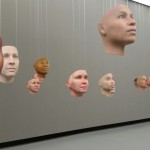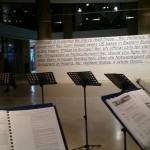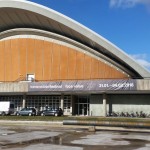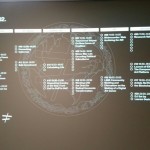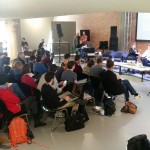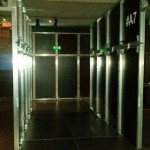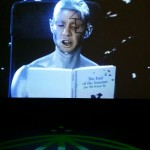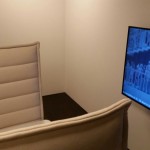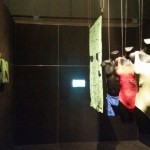The digital art raises problems and encourages thinking
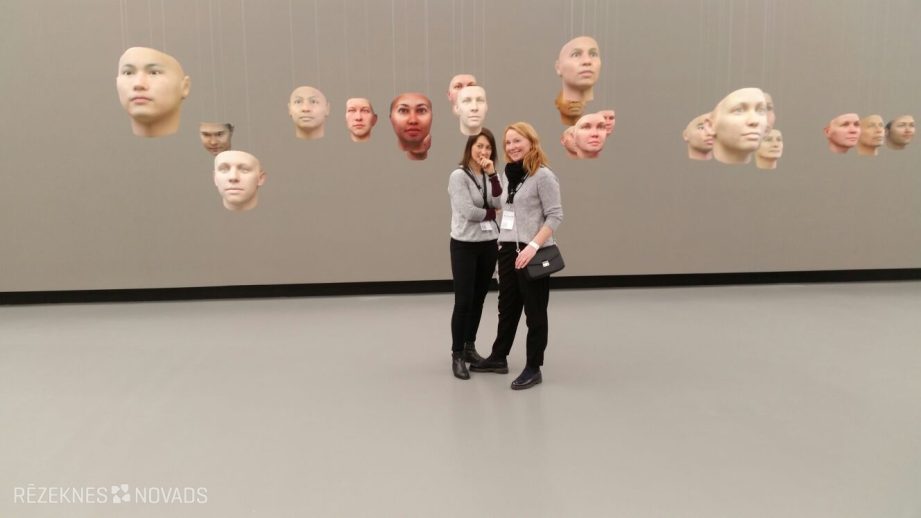
In order to meet the latest trends in the field of digital art, THE Lūznavas Manor manager Iveta Balzer and the Head of the Manor Culture Project, Inga Drele, visited the media art and digital cultural festival at the Berlin Transmediale face value from January 31 to February 4. This festival has been held for more than 30 years and has become one of the most important media art events in Europe. Festival participants – media professionals, ESPECIALLY arts, cultural, political professionals.
The opportunity to visit the Berlin Festival for Iveta and Ingai came through a scholarship of 500 euros received under the EUCIDA project (“digital art covers Europe”). Artists and cultural workers may be eligible for such co-financing in order to participate in an event related to the field of digital art (festival, seminar, creative workshops etc.) in one of the European countries.
As Iveta Balzer acknowledged, the intended purpose of the trip was fully justified, as the events of the Berlin Festival supplemented and enriched the idea of digital art, as well as the synthesis of culture and technology through which the artist expresses his views on topical political and social problems.
Iveta Balzer: In the Berlin Festival we could make sure that the digital art is updating very modern and very important developments in the future - refugee problems, environmental pollution, offshoring, political corruption, various facets IN THE EU's currency-making … it was all very strongly shown through new technologies.
The exhibition room was divided into ten smaller rooms, or boxos, separated from one another with black walls. In each of these rooms there was a social, political, artistic, economic problem, illuminated with the help of digital art, each of these stories reflected a global problem.
One of the boxers was the story of the future – “life without the Internet”, which is told by artificial intelligence on the wall. It seemed very mysterious and scary.
The exhibition also contained an exhibition with which a person can track the genetic code of his family, through DNA, by removing a sample of saliva. There were many faces projected on the walls of the hall, but the story is that our roots are very deep, both in the races and in the countries.
There was still an exhibition in which there was a gathering of mutual conversations between different countries in national radicals, taken from the Internet, they could see how this network was formed, that a man should be very careful about what he read and what he did in social networks, so that he was not accidentally retracted into a grouping. There is now a concept of media literacy.
More konferences were held every day, as well as smaller working groups in which the work took place in parallel. Interestingly, the debate on the digital currency – bitcoin – as well as the fact that the digital art, like any art genre, also has its own canons.
With the project, EUCIDA also brings the Rēzekne municipality closer to this digital world, encouraged to think that we are transforming today, moving from many traditional things to very modern things. Each of us is affected.
- The first digital art exhibition in Latgale was also held in THE EUCIDA at Lūznavas in the last year. How is Latgale viewers' attitudes to digital art change?
Iveta Balzer: I think we are already educators in this area. If you want to understand what the artist has wanted to say in a digital art exhibition, it is not enough to look at the material that is there, to read it, to go deeper to understand what the artist has wanted to say to it. For each exhibition hall, Luznava had his own story, the leaders of excursions told them, and in this way we educated the local community.
- how DOES Lūznavas manor digital art live alongside traditional art?
IN THE I.B. Lūznavas manor exhibition hall, the classical art, the Latgale podiers' business and the modern, digital art were indeed met last year. In total, 6000 people surveyed this exhibition, almost half of the groups were young people.
This year, on 19 May, a second international digital art exhibition will be opened at Lūznavas in Riga, to which we hope to invite traditional art representatives to participate in joint workshops with artists representing the area of digital art.
We have a new exhibition room - the former mustard wood barn is transformed into Culturys shkiuni, and the digital art exhibition will be the first exhibition in this new cultural space.
Every exhibition of this digital art is an amazing process where you don't know exactly what it will be. It is only when everything is built, inserted and launched that we have an exhibition, so we have a sense of excitement in our way. But on the basis of the experience of the previous year, we hope that this exhibition will also be a sort of magnet for people who drive to see the Rēzekne municipality, Lūznavas Manor, where they can see ultra-new and modern things in traditional spaces. "
The project “European Connections in Digital Arts – EUCIDA (digital art covers Europe)”, supported BY THE EU “Creative Europe” programme, is implemented from 1 July 2016 to 31 December 2019. The project partners are digital art centres in Dublin (Ireland), Belfort (France) and the municipality of Rezekne (Lūznavas maniža). The project coordinator in the municipality of Rezekne, Inta Rimšāne, believes that the project has encouraged learning, revealing much new, yet unknown.
Inta Rimšāne: "By these years, working with partners of other countries, we have realised that this is a whole new sphere, something that is very young in Latvia and Latgale in particular. We have both worked and learned much, because it is never too late to learn.
This is another kind of art, we are accustomed to perceiving art as something constant, stable, like a painting, sculpture. In contrast, digital art may exist for five minutes, hours, weeks and then disappear. You can ask if it's really art when it takes only five minutes, but why not? If we do this art for people at least these five minutes to think about something, about problems, what i am and how i feel in this world, the objective of these arts is achieved.
In September 2019, a digital art festival will be held in Rēzekne District, Lūznavas Manor. These will be talks on digital art, workshops to which we will call representatives from organisations in the world who have been working with digital art for many years. This festival will be a very big challenge for both us and Latgale.
For me, by visiting the festival in Berlin, the greatest surprise was that young people are able to speak, discuss, philosopy about art, politics, literature, mass media in the context of digital art. ”
As added Iveta Balzerthe boundary between traditional and digital art is not at all so violent. In parallel to the second international digital art exhibition Lūznavas, there will also be a laser workshop run by employees of the Rēzekne Technology Academy laser technology centre, as well as traditional art representatives – RTA trainers Diana Apele and Sylvia Mežinska. There are currently laser technology seminars where young people are learning this modern and interesting technology. The exhibition of the seminar participants will be opened in Loznava in 2019.
Iveta“We are pleased that, with these ultra-modern things, we can also return to the historic roots of the estate, as the artists also lived and worked here. The hundred-year-old history has been transformed into a new way. '
The duration of the EUCIDA project shall be from 1 July 2016 to 31 December 2019. The total budget of the project is EUR 344 000, of which EUR 41 000 is part of the co-financing of the municipality of Rezekne and EUR 41 885 is the financing of THE EU “Creative Europe” programme. During the project, all stakeholders had the opportunity to look at the digital art exhibitions created by Irish and French artists AT Lūznavas Manor, to meet the artists of different countries, as well as to visit creative workshops by testing the possibilities of digital laser equipment in the creation of artistic works. The project also offers opportunities for artist residences: the Rēzekne artist Gundega Strautmane worked for ten days at the Digital Art Center in Dublin (Ireland), while French artist Jacques Lopez was active IN Lūznavas manor and showed what works of art can be created using laser equipment. The project also offers scholarships for artists and cultural workers who can attend digital art exhibitions. More information on website www.reseknes novads.lv, accounts on social networks https://www.facebook.com/eucidaproject/
Anna Rancāne
Photo from Berlin Festival: Inta Rimšāne, Iveta Balzer
